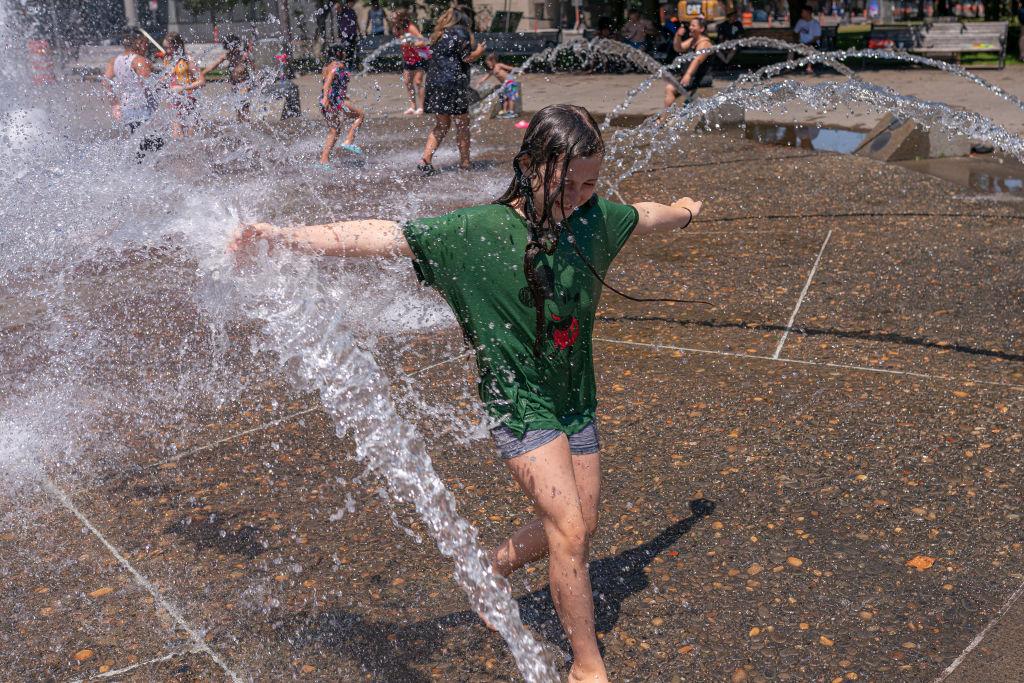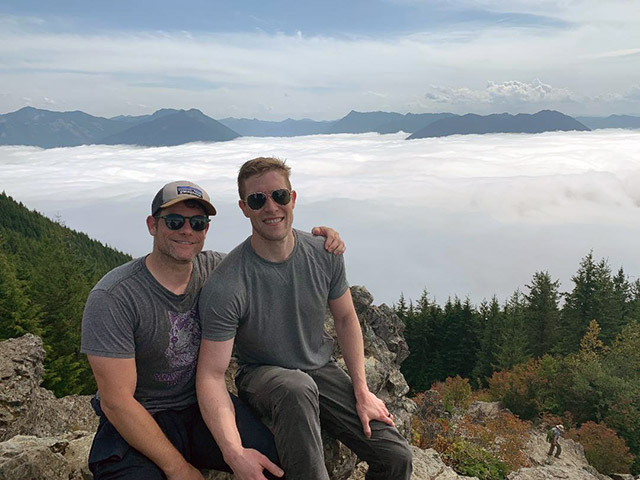
More than skin in the game
Q&A: A pediatric dermatologist sees global warming's effects in his patients: "Everyone is affected, but not equally."
Children are especially vulnerable to episodes of heat. Their physiology isn’t totally mature, and so they may have a harder time getting rid of excess body heat on hot days. For instance, can their heart beat fast enough to dissipate the heat?
Heat waves may also predispose to wildfires in our area, which adds to the stress on children’s bodies and risks to their health. The more pollution and smoke that comes in contact with their skin, the more it will be absorbed into their skin and lungs, triggering inflammation in the skin and the body.
On top of that, children have different behavior patterns that may put them at risk. We tell kids to go outside and play, but what if it’s 95 degrees or there’s wildlife smoke? There’s still all those particles in the air. They’re breathing more rapidly, with a higher respiratory rate than adults. Because their bodies are immature, this can make all those downstream effects of climate change more harmful to children, because the mechanisms that their body has to deal with these excess insults — pollution, inflammation, heat stress — are less developed than adults.
What trends or changes have you seen with the health effects associated with global warming?
With changes in temperature and microclimates, we’re seeing changes in disease patterns. Lyme disease is historically diagnosed primarily in New England states, but now it’s across upstate New York, Michigan, Pennsylvania, Minnesota and Wisconsin.
The world is changing in a way that infectious diseases have a greater niche they can occupy, such as Valley Fever in the San Joaquin Valley in California. When there’s intense rainfall, the fungus that causes Valley Fever starts to spore. You can get skin infections with that as well.
We used to think that this organism was only endemic to California, but they’ve found it in soil in Washington State now. It’s obvious that there are other infectious diseases that will be coming to our doorstep.
We’ve been slammed in the Seattle area for the past several years with high concentrations of wildfire smoke. You’ve previously said such smoke is hurting people’s skin and have likened it to the effects of a long-time cigarette smoker. How long does that take and what are the effects, if any, with these relatively short-term exposures?
I don’t know precisely and couldn’t give a specific length of time, though it is safe to say that any length of time being exposed to air pollution and smoke is bad for your skin, with more harmful effects at higher concentrations of these particles. There’s two different things I'd think about. If you’re talking about the direct effect of air pollution it makes the skin more dry, scaly and itchy.
Additionally, while there's not enough evidence to definitively prove that the small particles make it more likely to develop skin cancer with ultraviolet radiation, it is thought to contribute to development of skin cancer.
Are ticks increasingly becoming a problem in the Northwest as a result of global warming? What other health trends are you seeing here and elsewhere?
Ticks, specifically the ones that transmit Lyme disease, have not made their way here. With the warming world, Zika, West Nile virus, all these things that can be transmitted by mosquitoes, and again these are not currently problems in Western Washington, but a warming world will make our area more habitable for mosquitoes so we may eventually see these diseases more frequently here.
The one infectious disease to again be aware of, although I don’t want to cause alarm as there aren’t frequent cases of it yet reported, is Valley Fever, which thrives in really dry, warm conditions. If you think of the geography of Washington, a lot of the state is really hot. We have to remember it’s not the same as our microclimate here in Seattle.
Pediatric dermatology is your speciality. When did your interest in climate change begin and what drew you to the topic as a physician?
I guess I’ve always been someone who tried to ride my bike and recycle – I thought I was doing my part in the world and that was all I needed to do! Then in 2018, when I read the United Nation’s Intergovernmental Panel on Climate Change report, it hit me like, ‘Oh I didn’t realize how bad things were.’ The effects we worry about will not occur in some distant future, but to me and my children in our lifetimes.’ My two boys are 12 now. It was a sucker punch.
I take care of kids on a daily basis. After reading that report, for a few days I was in a deep depression about it, which I recognize now is a normal response for folks who recognize the enormity of the crisis.
Ultimately, I had to find my place of hope and optimism. I can push the institutions I work in and with to make them more aware. That’s a way to channel my despair into something more energetic and hopeful. I will say that my understanding of the climate crisis has allowed me to be more present in any given moment — appreciating a cool summer day, spending time with my family and friends — I don’t take that for granted the way I used to.
Why should dermatologists in particular become involved with climate change issues?
I think because it affects our patients most immediately. There are health care impacts and every discipline in health care will be affected by global warming and pollution from the burning of fossil fuels and wildfire smoke.
For dermatology specifically, we know climate change and air pollution lead to flares of atopic dermatitis, also called eczema. A study after the 2018 Camp Fire in California saw spikes in health care visits for atopic dermatitis and itch following the fire. It’s happening and we see it.
In 2020, we had a week of bad wildlife smoke in the Seattle area. That week I had a clinic for seeing patients with urgent skin issues. Eleven of 12 kids that came to see me that day had severe flares of atopic dermatitis that was secondary to the wildfire smoke.
I think we need to be prepared: What conditions will we see more of in a changing climate? We don’t have all the answers, but certainly it is important for us to be mindful that there are diagnoses that are currently less common in any given geographic location that may become more common with environmental changes.
With respect to smoke, it’s important to remember that it affects not just our lungs and our breathing. It doesn’t feel good to breathe that in, but what about your skin?
Are medical schools beginning to include global warming’s health impacts in their curriculum?
Yes, I think it’s definitely becoming a thing that medical schools are becoming aware of. An AMA resolution in 2019 supported including the health impacts of global climate change in the health care curriculum. We’ve surveyed pediatric residents here on this same question: Do you think you should be learning more about global warming and how it affects children’s health? The response was an emphatic yes.
As director of the dermatology residency program, do you have the opportunity to talk with residents about global warming’s effects on children?
Yes, I do all the time. We talk about climate change and air pollution. What I think is important to point out is that these are two sides of the same coin: what we’re talking about is burning fossil fuels. There is all this small particle pollution that negatively affects skin health and they need to know which infectious, inflammatory and allergic diseases are triggered by these changes in our environment.
My goal is to train residents to be excellent clinicians. To me, that doesn’t mean just knowing factoids or treatment algorithms; I want our trainees to put the patients we care for in the context of the world they are living in — income, housing, food scarcity, racism.
I see the effects of global warming as another social determinant of health. It has a profound effect on a patient's health, and our trainees need to be able to incorporate these factors into diagnosis and treatment plans to best serve each individual patient.
Are there local initiatives that you think are especially noteworthy?
There’s lots of things on an immediate local level you can do.

Green Seattle Partnership plans tree plantings and ecological restorations around the Seattle area.
I support Forterra, which preserves land so it doesn’t get developed and works to prioritize and preserve Indigenous knowledge.
When we’re thinking about the climate crisis, it’s important to remember that while everyone is affected, the climate crisis doesn't affect everyone equally,
Minoritized, relatively less wealthy communities both locally and worldwide bear the brunt of the negative effects of climate change.
There are people in our backyards who are disproportionately impacted. If you don't have a home with air conditioning, that’s a problem. There are all these barriers that can really harm people. Maybe tree planting isn’t your thing. But maybe staffing a cooling center is. Maybe your entryway into climate change issues is supporting communities that you care deeply about who are adversely affected by it.
Are there other ways to become involved?
I think divestment and understanding where we allocate our savings and wealth is another thing any one person can take a look at. Maybe we should think about if the places we bank at or the mutual funds that we invest in are socially responsible instead of propping up Big Oil and the fossil fuel industry. Everytime someone says ‘I don’t want to support this anymore,’ that’s a message to these organizations: This is important.
The issue is understanding how many small actions that may seem completely isolated from climate change actually still affect the planet.
However, it is important to contextualize this in the sense that people still need to be able to operate in the systems that currently govern the world we live in – that might mean driving cars and taking trips and using natural gas stoves. Not everyone has the means to make immediate changes that reduce greenhouse gas emissions.
One trap people can fall into when discussing individual action surrounding climate change: It can be very exclusive. Nobody should ever be shamed for doing their best for the planet, no matter how big or small the action. Come into the movement where you’re at. I think that’s a really important part of it: not to marginalize anyone who could be a potential climate advocate.
Written by Sharon Salyer
Media contact: mediarelations@uw.edu
For details about UW Medicine, please visit http://uwmedicine.org/about.